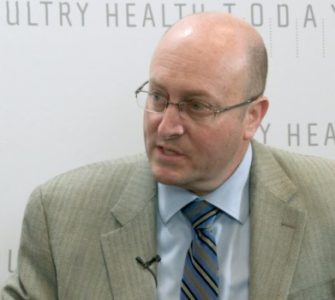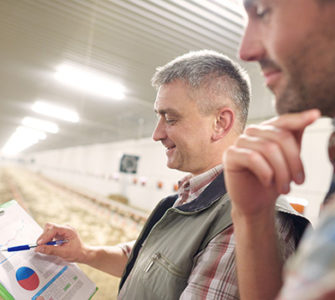Randall Singer: Therapeutics and antibiotic resistance
Please note: This article was reprinted in Poultry Informed Professional with the author’s permission from the 19th World Veterinary Poultry Association Congress in South Africa, September 2015.
Bacterial infections in humans that are resistant to antibiotics pose a significant and growing public health challenge globally [1]. Agricultural antibiotic use (AAU) can influence resistance in specific bacterial populations, and it is now well-documented that non-antibiotic compounds such as disinfectants and metals can also significantly impact the prevalence of resistant bacteria [2].
Within the poultry production system, there is a complex web of possible pressures affecting resistance in bacteria of importance to human and animal health. The real challenge is determining which practices are making the greatest contribution to the emergence, amplification, persistence and dissemination of antimicrobial resistance (AMR) and then accurately predicting the net benefit to human health that modification or elimination of these practices would have.
The broiler chicken and turkey systems have been linked to many antibiotic resistant infections in humans and are therefore critically important systems in which to develop and implement strategic programs for mitigating antibiotic resistance. For example, Salmonella enterica and Escherichia coli are both prevalent in the broiler production system and have become increasingly resistant to antibiotics. Almost 50% of human salmonellosis illnesses in the U.S. have been attributed to chicken [3], and as highlighted by recent multistate outbreaks, many of these Salmonella strains are multidrug resistant (MDR) [1]. While poultry only accounts for a small portion of foodborne-associated E. coli illnesses, it importantly might serve as a reservoir of resistance genes that can be transferred to other human pathogens. There is also the possibility that a small fraction of antibiotic resistant E. coli extraintestinal illness in humans can be attributed to chicken [4].
Linking AAU to human health
There are multiple pathways by which AAU can cause resistance to increase above background levels and then lead to a negative outcome (human health harm) (Figure 1, taken from Singer and Williams-Nguyen, 2014 [5]). In Pathway A, AAU leads to an increase in resistant pathogens which are then transmitted to humans via the food chain or the environment. The selection pressure exerted by the AAU in this scenario occurs on the farm. In Pathway B, AAU selects for resistance in non-pathogens, such as commensals or environmental microbes, which then transfer resistance genes to pathogens leading to more resistant infections in humans. Again selection in this case occurs on the farm. Finally, Pathway C involves the release of active antimicrobial compounds into the environment where selection occurs predominantly in non-pathogens, such as soil microbes, and resistance is transferred horizontally to pathogens as in B. Pathways B and C might be referred to as forces increasing the size of the resistance gene pool.
To estimate the risk to human health in each of these scenarios (or combinations of them), we must establish quantifiable, causal links and determine what the current state of evidence tells us about the relative importance and interconnectedness of these links. For example, knowing that a human illness was caused by a resistant bacterium that originated from a specific poultry operation (the proverbial smoking gun) does not necessarily help us understand WHY the bacterium was resistant. The resistance in this bacterium was unlikely to have been created de novo by the AAU on the source farm. Many of the resistance genotypes, particularly when associated with multidrug resistance plasmids, have a global distribution [6-9].
Antibiotic use in poultry production
Most studies of the relationship between antibiotic use and resistance in the poultry production system have focused on antimicrobial growth promoters (AGP) [10-12]. Results of these studies have varied, but in general there has been an observed decrease in resistance to individual antibiotics in specific bacteria when AGPs were removed. In Europe, where the AGP have been banned, the commensal strains of E. coli from broilers in Denmark had reduced prevalence of resistance to sulfonamides and ampicillin but negligible changes to tetracycline and streptomycin [13,14]. With the recent finalization of Guidance for Industry #213 by the USFDA, the administration of medically-important AGPs will be phased out over the next three years [15,16]. Consequently, it is more important to address the consequences, both positive and negative, of removing AGP from poultry production than to continue evaluating the potential for these uses to select for resistance.
Following the removal of AGPs in Europe, broiler chickens experienced a significant increase in necrotic enteritis (NE) [17-19], an extremely costly disease caused by C. perfringens [18]. AGP dosing regimes with antibiotics such as bacitracin, virginiamycin, avoparcin, lincomycin, tylosin, and penicillin were able to limit morbidity associated with NE [20], but the increased incidence resulted in increases in antibiotic usage for NE disease prevention, treatment and control [17,21]. Infection with coccidian parasites has been shown to increase the likelihood of NE due to improved growth conditions for C. perfringens, and therefore, products that reduce coccidia such as ionophores [18,19,22-24] have been shown to decrease the incidence of NE [25]. What remains uncertain is whether the ionophores and the antibiotics used to prevent NE will have an impact on antibiotic resistance in poultry.
Given that there are at least 7 antibiotic compounds used in the U.S. for the prevention of NE in broilers, studies are needed to examine the impact that these antibiotic administrations may have on resistance. Furthermore, antibiotics are commonly used in the hatchery for the control of early mortality associated with bacteria such as E. coli and Salmonella. The only two approved antibiotics in the U.S., gentamicin and ceftiofur sodium, are given subcutaneously in the day-old chick as labeled. Gentamicin though is most commonly administered extralabel in ovo; following the ban of extra-label cephalosporin administration [26], ceftiofur cannot be used in this manner. In summary, very few of the non-AGP antibiotics approved for use in poultry have been evaluated directly for their impact on resistance, and therefore, quantifying the effect of AAU on human health through Pathways A, B or C, as shown in Figure 1, is problematic.
Antibiotic resistance and human health
Very few of the most important antibiotic resistant infections of humans have a direct relationship to agriculture (1). Some scientists have begun linking E. coli in chicken with human illness is not as widely recognized. As depicted in Figure 1, E. coli can serve as commensal bacteria that potentially transfer resistance to human pathogens via Scenario B. However, recent studies suggest that E. coli that cause human disease outside of the GI tract, known as Extraintestinal Pathogenic E. coli (ExPEC), have considerable genetic similarity to E. coli in animals. E. coli that cause disease in chickens, broadly known as avian pathogenic E. coli (APEC), have many of the same virulence factors as the human ExPEC strains. AMR in ExPEC and APEC strains is common, and thus there is the potential for resistant E. coli to infect humans through Scenario A of Figure 1 as well. The role of APEC in human disease, however, is questionable.
The antimicrobial resistance genes found among E. coli and Salmonella are numerous and diverse [27-35]. In addition to harboring antibiotic resistance genes, plasmids of E. coli and Salmonella may also harbor genes encoding tolerance to heavy metals and disinfectants. Resistance towards a particular antibiotic can thus be a result of direct or indirect selection. For example, the use of gentamicin in ovo or in day-old chicks could directly select for E. coli and Salmonella that possess plasmids such as the IncHI2 plasmid pAPEC-O1-R (Figure 2) and the IncA/C plasmid p199061_160 (Figure 3). Selection of these plasmids through use of gentamicin would result in the co-acquisition of genes conferring resistance towards tetracycline, sulfisoxazole, copper compounds, silver compounds, and quaternary ammonium compounds. The reverse might also be true; use of heavy metals or disinfectants could directly select for E. coli and Salmonella harboring these resistance plasmids, thus co-selecting for AMR. Importantly, strains of E. coli and Salmonella within the poultry production system possess resistance to medically-important antibiotics, including the third-generation cephalosporins.
Antibiotic resistance is a critically important issue affecting health of human and animal populations. Although the role of poultry production practices in augmenting levels of antimicrobial resistance in key bacteria is uncertain, there are many practices in poultry production that have the potential to exacerbate the problem and aid in the selection, persistence and dissemination of resistance. In addition to using antibiotics in a responsible manner, we must also determine the effects that non-antibiotic uses, such as metals and disinfectants, have on resistant bacteria in the poultry production system.
By
Randall S. Singer, DVM, MPVM, PhD
Department of Veterinary and Biomedial Sciences
University of Minnesota, St. Paul, MN
References
1. (CDC), C. f. D. C. a. P.: Antibiotic Resistance Threats in the United States, 2013. Edited by; 2013.
2. Singer, R. S., M. P. Ward, G. Maldonado: Can landscape ecology untangle the complexity of antibiotic resistance? Nature Reviews Microbiology 2006, 4:943-952.
3. Guo, C., R. M. Hoekstra, C. M. Schroeder, S. M. Pires, K. L. Ong, E. Hartnett, A. Naugle, J. Harman, P. Bennett, P. Cieslak, et al.: Application of Bayesian techniques to model the burden of human salmonellosis attributable to U.S. food commodities at the point of processing: adaptation of a Danish model. Foodborne Pathogens and Disease 2011, 8:509- 516.
4. Nordstrom, L., C. M. Liu, L. B. Price: Foodborne urinary tract infections: a new paradigm for antimicrobial-resistant foodborne illness. Front Microbiol 2013, 4:29.
5. Singer, R. S., J. Williams-Nguyen: Human health impacts of antibiotic use in agriculture: A push for improved causal inference. Curr Opin Microbiol 2014, 19:1-8.
6. Call, D. R., R. S. Singer, D. Meng, S. L. Broschat, L. H. Orfe, J. M. Anderson, D. R. Herndon, L. S. Kappmeyer, J. B. Daniels, T. E. Besser: blaCMY-2 -positive IncA/C plasmids from Escherichia coli and Salmonella enterica are a distinct component of a larger lineage of plasmids. Antimicrobial Agents and Chemotherapy 2010, 54:590-596.
7. Fernandez-Alarcon, C., R. S. Singer, T. J. Johnson: Comparative genomics of multidrug resistance-encoding IncA/C plasmids from commensal and pathogenic Escherichia coli from multiple animal sources. PLoS One 2011, 6:e23415.
8. Baquero, F., A. P. Tedim, T. M. Coque: Antibiotic resistance shaping multi-level population biology of bacteria. Front Microbiol 2013, 4:15.
9. Johnson, T. J., K. S. Lang: IncA/C plasmids: An emerging threat to human and animal health? Mob Genet Elements 2012, 2:55-58.
10. Fairchild, A. S., J. L. Smith, U. Idris, J. Lu, S. Sanchez, L. B. Purvis, C. Hofacre, M. D. Lee: Effects of orally administered tetracycline on the intestinal community structure of chickens and on tet determinant carriage by commensal bacteria and Campylobacter jejuni. Applied and Environmental Microbiology 2005, 71:5865-5872.
11. Danzeisen, J. L., H. B. Kim, R. E. Isaacson, Z. J. Tu, T. J. Johnson: Modulations of the chicken cecal microbiome and metagenome in response to anticoccidial and growth promoter treatment. PLoS One 2011, 6:e27949.
12. Debnam, A. L., C. R. Jackson, G. E. Avellaneda, J. B. Barrett, C. L. Hofacre: Effect of growth promotant usage on enterococci species on a poultry farm. Avian Diseases 2005, 49:361- 365.
13. DANMAP: DANMAP 2008. Use of antimicrobial agents and occurrence of antimicrobial resistance in bacteria from food animals, foods and humans in Denmark; 2009.
14. DANMAP: DANMAP 2012. Use of antimicrobial agents and occurrence of antimicrobial resistance in bacteria from food animals, food and humans in Denmark; 2013.
15. U.S. Food and Drug Administration, C. f. V. M.: Guidance for Industry #209: The Judicious Use of Medically Important Antimicrobial Drugs in Food-Producing Animals. Edited by; 2012. vol Document No. 209 Available at: AnimalVeterinary/GuidanceComplianceEnforcement/GuidanceforIndustry/UCM216936.pdf.]
16. U.S. Food and Drug Administration, C. f. V. M.: Guidance for Industry #213: New Animal Drugs and New Animal Drug Combination Products Administered in or on Medicated Feed or Drinking Water of Food-Producing Animals: Recommendations for Drug Sponsors for Voluntarily Aligning Product Use Conditions with GFI #209 Edited by; 2012. vol Document No. 209 Available at: AnimalVeterinary/GuidanceComplianceEnforcement/GuidanceforIndustry/UCM216936.pdf.]
17. Casewell, M., C. Friis, E. Marco, P. McMullin, I. Phillips: The European ban on growthpromoting antibiotics and emerging consequences for human and animal health. Journal of Antimicrobial Chemotherapy 2003, 52:159-161.
18. Shojadoost, B., A. R. Vince, J. F. Prescott: The successful experimental induction of necrotic enteritis in chickens by Clostridium perfringens: a critical review. Vet Res 2012, 43:74. Page 6
19. Van Immerseel, F., J. De Buck, F. Pasmans, G. Huyghebaert, F. Haesebrouck, R. Ducatelle: Clostridium perfringens in poultry: an emerging threat for animal and public health. Avian Pathol 2004, 33:537-549.
20. Butaye, P., L. A. Devriese, F. Haesebrouck: Antimicrobial growth promoters used in animal feed: effects of less well known antibiotics on gram-positive bacteria. Clinical Microbiology Reviews 2003, 16:175-188.
21. Wierup, M.: The Swedish experience of the 1986 year ban of antimicrobial growth promoters, with special reference to animal health, disease prevention, productivity, and usage of antimicrobials. Microb Drug Resist 2001, 7:183-190.
22. Grave, K., M. C. Kaldhusdal, H. Kruse, L. M. Harr, K. Flatlandsmo: What has happened in norway after the ban of avoparcin? Consumption of antimicrobials by poultry. Preventive Veterinary Medicine 2004, 62:59-72.
23. Grave, K., V. F. Jensen, K. Odensvik, M. Wierup, M. Bangen: Usage of veterinary therapeutic antimicrobials in Denmark, Norway and Sweden following termination of antimicrobial growth promoter use. Prev Vet Med 2006, 75:123-132.
24. Van Immerseel, F., J. I. Rood, R. J. Moore, R. W. Titball: Rethinking our understanding of the pathogenesis of necrotic enteritis in chickens. Trends Microbiol. 2009, 17:32-36.
25. Collier, C. T., C. L. Hofacre, A. M. Payne, D. B. Anderson, P. Kaiser, R. I. Mackie, H. R. Gaskins: Coccidia-induced mucogenesis promotes the onset of necrotic enteritis by supporting Clostridium perfringens growth. Vet Immunol Immunopathol 2008, 122:104-115. 26. New Animal Drugs; Cephalosporin Drugs; Extralabel Animal Drug Use; Order of Prohibition. Edited by Food and Drug Administration H; 2012:735-745. vol 77.]
27. Antunes, P., J. Mourao, J. Machado, L. Peixe: First description of qnrS1-IncN plasmid in a ST11 Salmonella Enteritidis clinical isolate from Portugal. Diagn Microbiol Infect Dis 2011, 69:463-465.
28. Carattoli, A., L. Villa, L. Poirel, R. A. Bonnin, P. Nordmann: Evolution of IncA/C blaCMY-(2)- carrying plasmids by acquisition of the blaNDM-(1) carbapenemase gene. Antimicrob Agents Chemother 2012, 56:783-786.
29. Foley, S. L., A. M. Lynne: Food animal-associated Salmonella challenges: pathogenicity and antimicrobial resistance. J Anim Sci 2008, 86:E173-187.
30. Garcia Fernandez, A., A. Cloeckaert, A. Bertini, K. Praud, B. Doublet, F. X. Weill, A. Carattoli: Comparative analysis of IncHI2 plasmids carrying blaCTX-M-2 or blaCTX-M-9 from Escherichia coli and Salmonella enterica strains isolated from poultry and humans. Antimicrob Agents Chemother 2007, 51:4177-4180.
31. Phuc Nguyen, M. C., P. L. Woerther, M. Bouvet, A. Andremont, R. Leclercq, A. Canu: Escherichia coli as reservoir for macrolide resistance genes. Emerg Infect Dis 2009, 15:1648-1650.
32. Poirel, L., R. A. Bonnin, P. Nordmann: Analysis of the resistome of a multidrug-resistant NDM-1-producing Escherichia coli strain by high-throughput genome sequencing. Antimicrob Agents Chemother 2011, 55:4224-4229.
33. Yong, D., M. A. Toleman, C. G. Giske, H. S. Cho, K. Sundman, K. Lee, T. R. Walsh: Characterization of a new metallo-beta-lactamase gene, bla(NDM-1), and a novel erythromycin esterase gene carried on a unique genetic structure in Klebsiella pneumoniae sequence type 14 from India. Antimicrob Agents Chemother 2009, 53:5046-5054.
34. Johnson, T. J., K. E. Siek, S. J. Johnson, L. K. Nolan: DNA sequence and comparative genomics of pAPEC-O2-R, an avian pathogenic Escherichia coli transmissible R plasmid. Antimicrobial Agents and Chemotherapy 2005, 49:4681-4688.
35. Johnson, T. J., Y. M. Wannemeuhler, J. A. Scaccianoce, S. J. Johnson, L. K. Nolan: Complete DNA sequence, comparative genomics, and prevalence of an IncHI2 plasmid occurring among extraintestinal pathogenic Escherichia coli isolates. Antimicrob Agents Chemother 2006, 50:3929-3933.
Posted on April 3, 2016




















